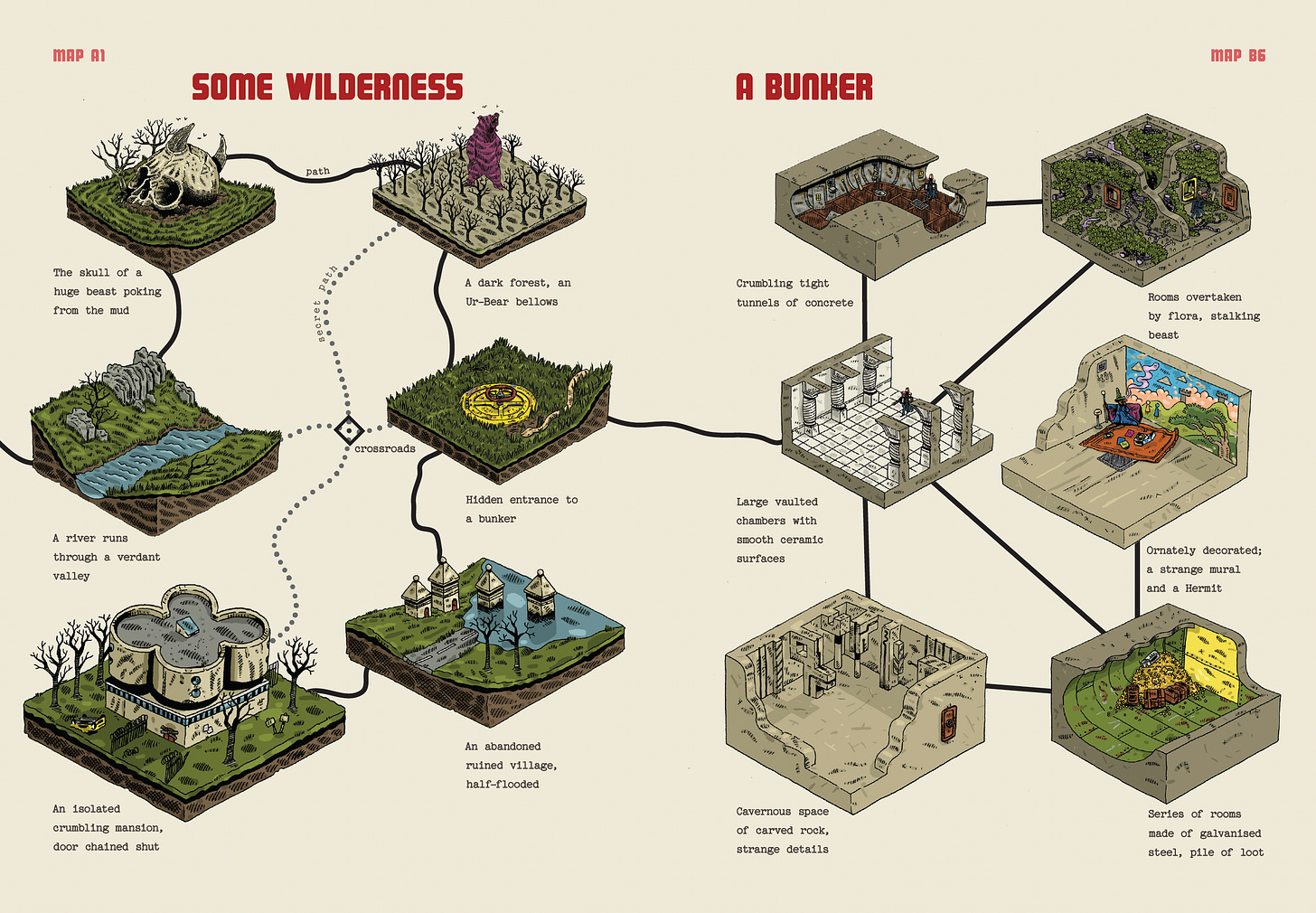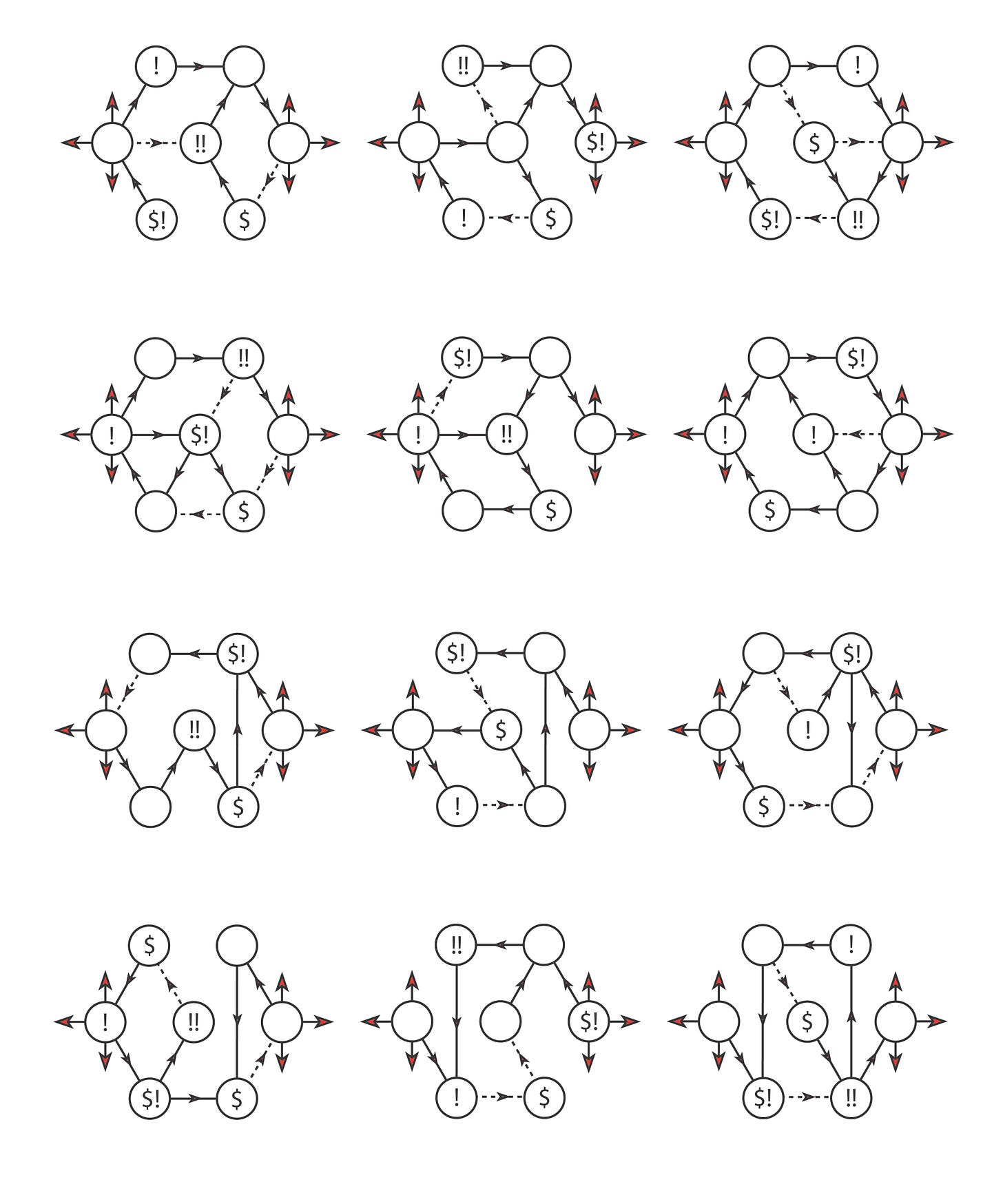Multi-purpose Maps
Need a map for your game tonight, but run out of time/spoons?

I’ve been working away at the idea of multi-purpose maps for a while now. Initially, I started making them for my home games as I realised it was the one thing that I needed to run an adventure at short notice. Then that grew into the whole system for the games that I’m making now with Dan. Obviously, you can just create a simple point crawl in seconds- draw a few circles and join them up, hey presto. But that doesn’t give you a structure that will necessarily be interesting to play. By interesting to play, I mean have real choices for the PCs, to create a rich, layered experience. And the key to rich adventures is following the example of Jennell Jaquays and her dungeon design, as seen in Caverns of Thracia, Dark Tower, Griffin Mountain, and more, that have been dissected by the hobby and come to be known as Jaquaysing. Several key concepts were introduced-
Non-linearity - This, for me is key. There should be interesting choices that have an impact on the player’s journey. Both the “railroad” (a straight line towards a set destination) and the “quantum ogre” (the ogre turns up no matter which route you take or dorr you open) diminish player agency, and add to a sense that what the players do don’t actually impact their experience of play. Meaningful choices are what ttrpgs are great at. It does require a certain style of GMing,, which is maleable and reactive, but I believe this ends up in the best experience for everyone.
Loops - Loops make a place feel real and lived in. You caome back to the same place twice, and there’s a different situation - time has moved on, a bandit camp you saw before has left, leaving a smoldering fire, a door is open that was previously closed. Especially when you’re generating scenarios on the go, as I like to do, using tables to populate a space, having a loop so that the generated area now feels perminent is essential.
Secret or unusual paths - These are here to keep players investigating the world. The more they look and poke around, the more often they’ll be rewarded by finding another way through, perhaps leading to a safer route, or one with interesting items. This obviously goes hand in hand with linearity, but the presence of secret routes also subtly encourages a certain attitude and style of play from the players, that questions their surroundings, making them more invested in play.
The original post (which unfortnately gives the process a different name) lists a few more. I mean I love non-Euclidean geometry, but that’s basically a fancy secret route, and multiple entrances are another form of non-linearity.
When mapping out an adventure, what’s important for me is creating meaningful choices, rewarding exploration, and generating the feeling of an organic, lived-in place. This applies whether you’re investigating a dungeon, a forest or an abandoned cloud city.
So I wanted to create a few maps that would cover these issues, and have a little “adventure structure” baked in. This is partly inspired by the five-room dungeon and by Marcis B.’s inspired dissection of old-school dungeon design.
In Marcia’s schema, a six room dungeon has:
1 monster room with treasure.
1 monster room without treasure.
1 unoccupied room with treasure.
3 “empty” rooms.
It’s important to remember that this whole schema relies on the extra layer of random encounters. Typically, you roll a d6 on entering any room, and on a 1 you roll an encounter. And with a reaction roll, that encounter is further complicated- maybe it’s a troop of friendly goblins, or a very angry pixie. So in 6 rooms, or spaces, you’re likely to have 1 random encounter to add into the mix.
But why 6 rooms? 6 rooms is pretty much the length of one session, if you include chit-chat, breaks, etc. The 5 room dungeon (sorry this is not the “original” but I can’t find that right now) idea was based on that premise, but baked in an idea of narrative, that there should be an arc to the session. I understand the compulsion, but, as you may have guessed, for me this lacks player agency:
• Room 1: Entrance And Guardian
• Room 2: Puzzle Or Roleplaying Challenge
• Room 3: Red Herring
• Room 4: Climax, Big Battle Or Conflict
• Room 5: Plot Twist
I prefer the joys of the smaller triumphs- cleverly sneaking around the dragon, swimming up the underground stream to enter the compound. But I also think it’s good to have a sense of reward for clever play and exploration, so for my maps I baked in Marcia B’s options, with an awareness of danger and reward, knowing that if those are present, stories will emerge.
So here are 12 seven room dungeons I made recently for my current project. I’ve added 1 room to Marcia’s 6, and in most cases one extra baked-in event, for a little more incident and need for decision-making. It also gives more variety, and fits in a satisfying hex shape. If I need one as I’m designing a session, or even during play as the players inevitably go off-piste, I roll a d12 and populate it from a suitable table.
Edit: Another key influence, as ever, was from Chris McDowall’s Mythic Bastionland (in my haste I forgot about this one!). Chris sets up a procedure for a 6 point map, with 6 points of a hex and a central point, then removing one to create irregularity. This is a great approach. I think by varying routes like in the 12 below, you get a similar outcome.
Now this is where it gets fun. These don’t just have to be dungeons. They don’t even just have to be structures or buildings. They can be maps of whole areas or worlds- you just have to adjust the sense of scale.

For an interior, like a dungeon, this is a series of rooms connected by corridors. But out on the waves, these are a series of islands connected by shipping lanes (defined by safe passage, currents and prevailing winds). See the little arrows? Those are the currents, circulating between the islands. Travel against the current is harder, but not impossible - so that creates more sets of interesting choices. But then this could also be a map of an area, with villages, cities and caverns marked by the different sets of symbols. Or a map of a solar system, with different routes between different types of planets.
So here’s a few different schemes:
Dungeon
Every point is a new room, 1-in-6 chance of an encounter.
Travelling between Rooms takes 10 mins at a careful pace.
Lines are corridors.
Dotted lines are secret ways.
Arrows show elevation change.
Every ! generate an encounter.
Every $ generate a treasure.
Seas
Every point is is an island.
Travelling between Islands, the GM calculates the number of Watches it would take for the party to reach their destination. Roll a d8 for a simple journey through the Shallows, a d12 through the Deep, and a d20 through Abyssal waters. Each day is 6 Watches.
Lines are routes through the Shallows
Arrows show directions of currents
Dotted lines are routes through the more dangerous Deep seas.
If no line connects two points, travel can be made through the treacherous Abyssal seas.
No symbol denotes a Natural Island
$! or ! is a Volcanic Island
!! is an Artificial Island
Wandering over Weeks
At Week scale these maps are a series of overland locations connected by routes, showing the lie of the land. Moving between each point takes a number of Days (roll d3), adventuring through Terrain (roll d6 on the Terrain table).
Locations are marked by symbols. Empty spaces are a local feature, such as a hill or clearing.
Locations d3 - 1. Lair 2. Stronghold 3. Bunker
Terrain d6
1-3. Wastelands
4-5. Wilderness
6. Ruins
In other news, here are some great Mothership campaigns coming up soon :
Certain Fathoms by Grinning Rat Productions, Explore Welkin Campus—a shifting, sprawling, drowned facility of rogue machines, failed clones, and paracausal tech—in this Mothership-compatible depth-crawl module.
FLATLINE ON THE BLOCKS: A dicey district for Mothership RPG- Eighteen Mothership veterans tear open the Spinal Crux District, a 52pg zine detailing the EYE and its twenty Blocks on Prospero’s Dream.
And then there’s:
Our very own Islands of Weirdhope that bakes these maps into a sea setting, with tables and tables of sites and strangeness to explore. Follow for a free pdf of the Quickstart.


I've really enjoyed the new hex format, especially with the addition of arrows. It's given me a bunch of inspiration for overland travel.
"These don’t just have to be dungeons. They don’t even just have to be structures or buildings. They can be maps of whole areas or worlds"
This is a very well timed post for me as I'm trying to figure out if I can design a Vaesen mystery as if it were a dungeon (dungeons feel easy to bring to the table, mysteries feel overwhelming somehow). I stalled on the project a few weeks ago but this has got me scribbling in my notebook again, thank you!